

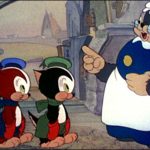
 Today’s animator breakdown is a Walter Lantz cartoon released in the early 1940s!
Today’s animator breakdown is a Walter Lantz cartoon released in the early 1940s!
Before starting in animation, aviation student Alex Lovy enrolled at the Curtiss-Wright Technical Institute in Glendale. There, he met and befriended Bill Littlejohn. Then, in 1933, financial circumstances beset by the Depression landed Lovy (and Littlejohn) at the Van Beuren Corporation in New York. Lovy started as an inker at Van Beuren but soon advanced to the story department shortly after Burt Gillett became the studio manager in the mid-thirties. Then, in 1936, when Van Beuren shuttered its animation department, Lovy migrated to Paul Terry’s studio in New Rochelle and was hired as a layout artist.
Lovy’s stay at Terry’s was relatively brief, migrating to the West Coast to apply at Walt Disney’s studio. Instead, Walter Lantz recruited Lovy as a story sketch artist, officially on the payroll on June 28, 1937. A few months later, Lantz promoted Lovy to a directorial position. His first cartoon as director, Feed the Kitty (released in March 1938), concluded the series starring Oswald the Lucky Rabbit. As a director, Lovy drew the character models in his cartoons for Lantz.
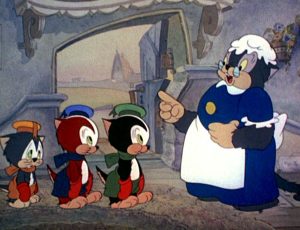 In early 1938, Hugh Harman and Rudy Ising struggled to survive after MGM renounced its connection with their studio. As a result, a mass layoff occurred, leaving several staffers flocking to various animation studios. Two ex-Harman-Ising animators, Frank Tipper and Al Coe, secured jobs at Lantz. (More information on those events in my animation research blog.)
In early 1938, Hugh Harman and Rudy Ising struggled to survive after MGM renounced its connection with their studio. As a result, a mass layoff occurred, leaving several staffers flocking to various animation studios. Two ex-Harman-Ising animators, Frank Tipper and Al Coe, secured jobs at Lantz. (More information on those events in my animation research blog.)
On August 21, 1939, Lovy began direction, likely preparing the character layouts and timing for his animators, on a production named Kittens’ Mittens, a variation on the Mother Goose story of “Three Little Kittens.” Besides Frank Tipper and Al Coe, three other animators provided footage in the cartoon: LaVerne Harding, George Dane, and veteran animator Hicks Lokey.
 In the cartoon, the three little kittens (voiced by Berneice Hansell and Margaret McCay) ridicule an orphan while playing outside before they lose their mittens after falling into a brook. When they arrive home, the kittens lie to their mother and claim that a wayfaring robber stole their mittens; Frank Tipper animated a fantasy sequence that embellishes their tall tale. After their mother reports the phony theft to the police, multiple “suspicious characters” are apprehended and sent to a line-up for the kittens to identify their culprit. Al Coe animated the close-ups of lawbreakers standing at the line-up, with the innocent orphan kitten rounded up as a suspect.
In the cartoon, the three little kittens (voiced by Berneice Hansell and Margaret McCay) ridicule an orphan while playing outside before they lose their mittens after falling into a brook. When they arrive home, the kittens lie to their mother and claim that a wayfaring robber stole their mittens; Frank Tipper animated a fantasy sequence that embellishes their tall tale. After their mother reports the phony theft to the police, multiple “suspicious characters” are apprehended and sent to a line-up for the kittens to identify their culprit. Al Coe animated the close-ups of lawbreakers standing at the line-up, with the innocent orphan kitten rounded up as a suspect.
Lovy handed out the last scenes, all set for animation on October 17, 1939. Victor McLeod, the credited story man and the robber’s voice in the cartoon, was taken off the payroll the following day, on October 18. As an independent producer selling cartoons to Universal since 1935, Lantz confronted economic disadvantages during the production of Kittens’ Mittens. Lantz’s weekly advances from Universal, the primary source of capital at his studio, had ended, which required Walter to fund his cartoons. The following month, on November 25, Alex Lovy and Verne Harding were off the payroll.
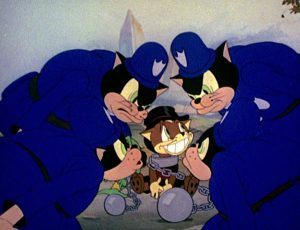 Kittens’ Mittens was released on February 12, 1940. A few days later, on February 24th, unable to provide the necessary finances to keep his studio operating, Lantz closed its doors. Two more cartoons, Adventures of Tom Thumb Jr. and 100 Pygmies and Andy Panda, entered theaters after Kittens. Lantz’s animators volunteered to produce an Andy Panda, Crazy House, for free, providing Universal the collateral to bankroll more cartoons. Lantz reinstated Alex Lovy on the payroll on August 5, 1940, along with Verne Harding the following week on August 12.
Kittens’ Mittens was released on February 12, 1940. A few days later, on February 24th, unable to provide the necessary finances to keep his studio operating, Lantz closed its doors. Two more cartoons, Adventures of Tom Thumb Jr. and 100 Pygmies and Andy Panda, entered theaters after Kittens. Lantz’s animators volunteered to produce an Andy Panda, Crazy House, for free, providing Universal the collateral to bankroll more cartoons. Lantz reinstated Alex Lovy on the payroll on August 5, 1940, along with Verne Harding the following week on August 12.
Meanwhile, Victor McLeod migrated to the main Universal lot as a screenwriter of B features. Then, in late 1940, McLeod took another writing job for George Pal’s new series of animated stop-motion films for Paramount. Next, Al Coe took a job at Walt Disney’s studio, later becoming a mainstay in Jack Hannah’s unit in the mid-forties. Later, in 1959, when Hannah departed from Disney to accept a directorial position at Lantz, Al Coe followed him. Hannah resigned from Lantz in 1961, but Coe chose to stay, becoming one of the studio’s principal animators in theatricals and commercials until the studio’s final closure in 1972.
The syndicated television version featured in the Columbia House Woody Woodpecker and Friends set has its share of censorship. In the film, the three little kittens disparage the orphan cat for having no parents or mittens; the mention of his parents is cut, but the dialogue related to his mittens is retained. (The animator breakdown video below reinserts the omitted scenes from a different picture source.)
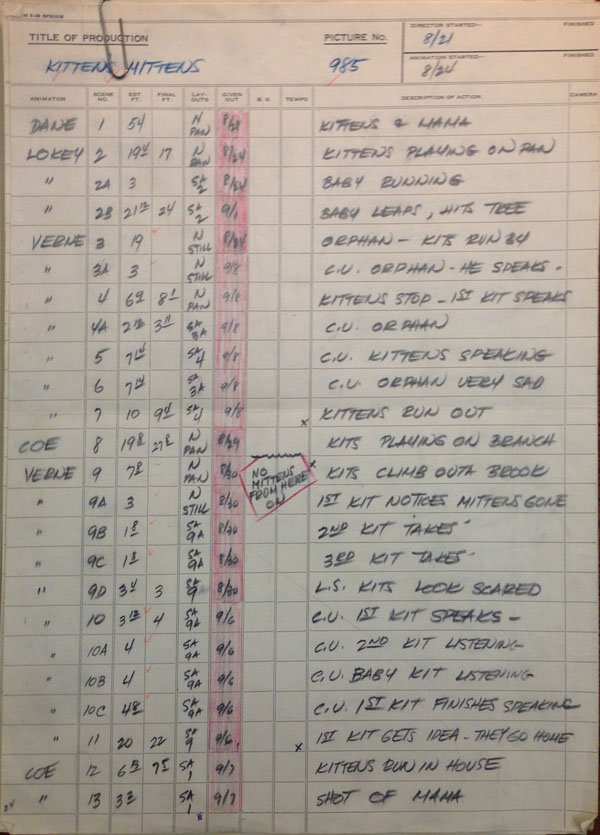


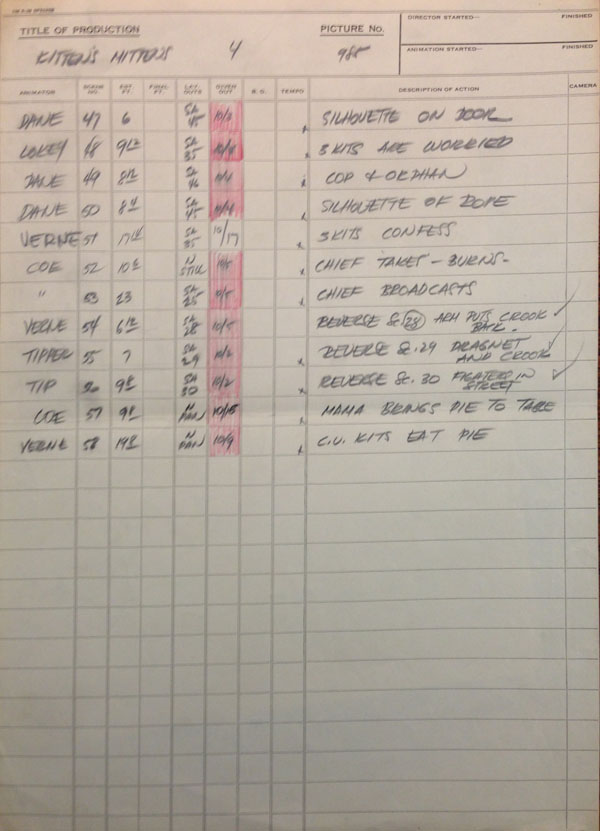
• As a side note, animator breakdowns of two black-and-white Lantz cartoons released in 1939, directed by Alex Lovy, are on my Patreon page: Bola Mola Land and Nellie of the Circus.
Thanks to Tom Klein, Joe Adamson, Michael Barrier, Mark Kausler, Yowp, and Keith Scott for the information and production materials.